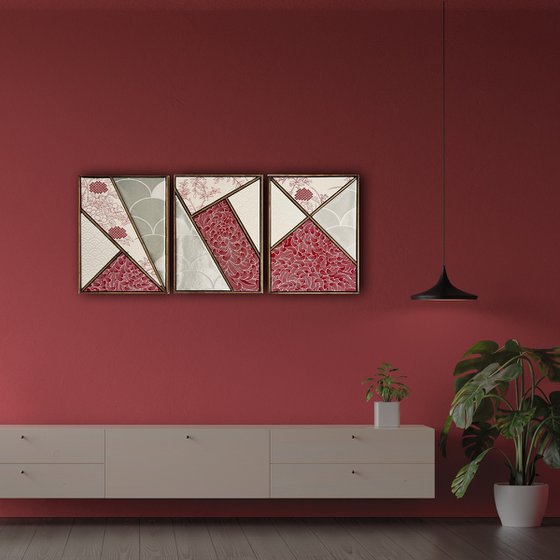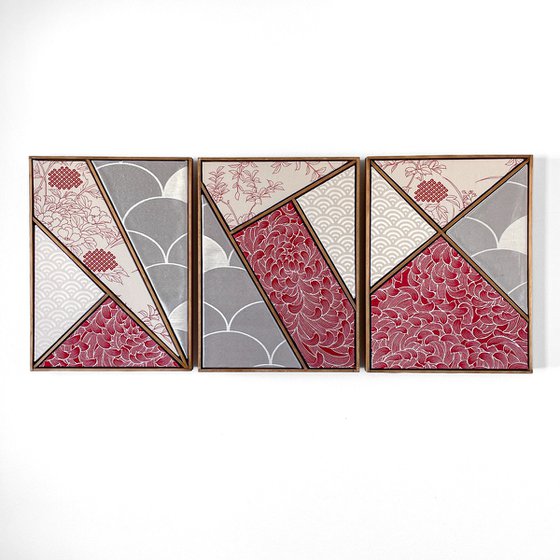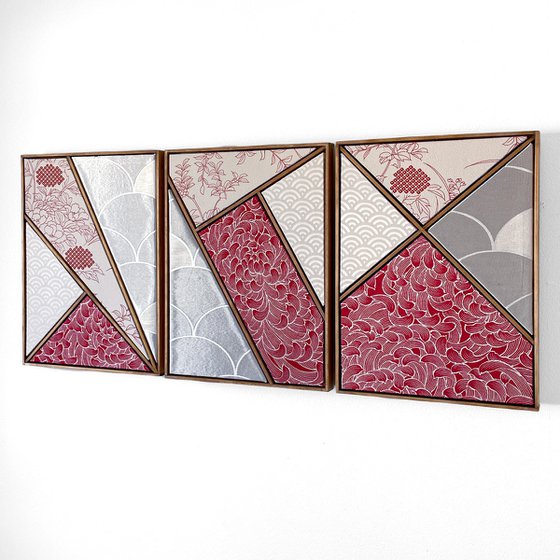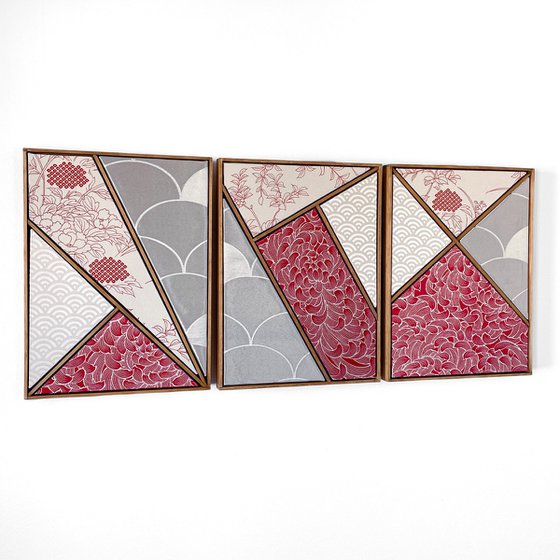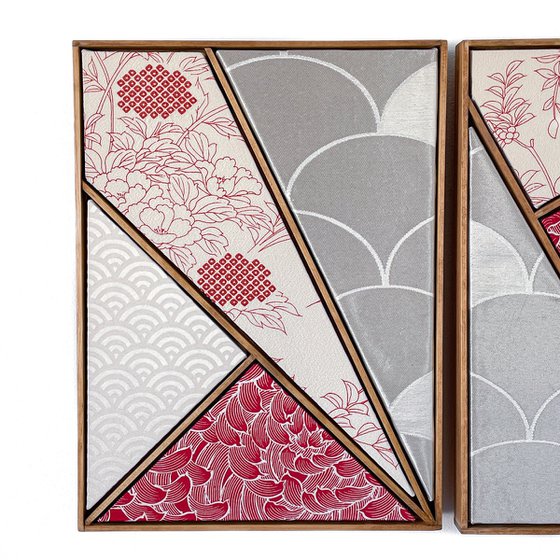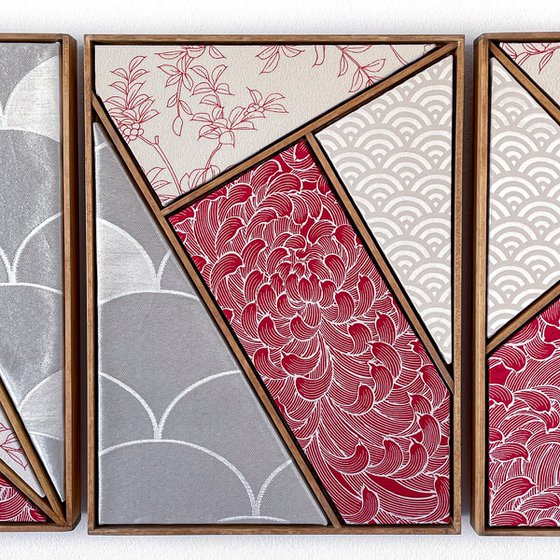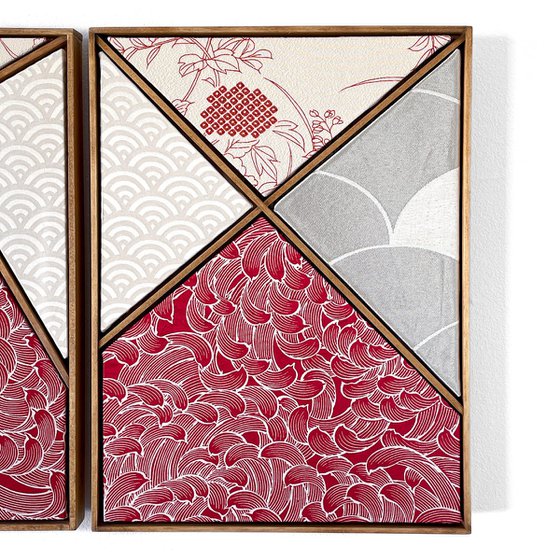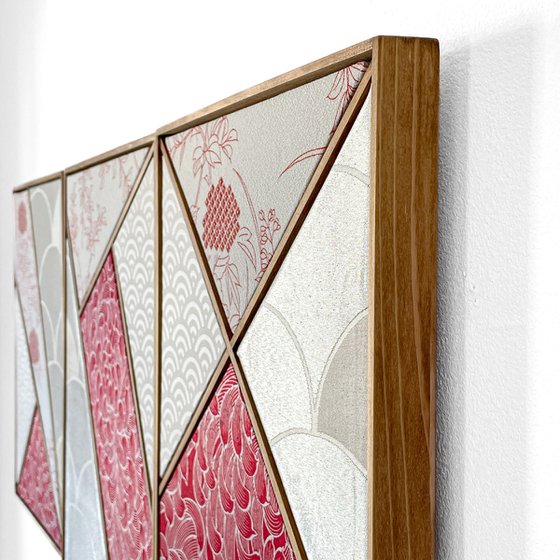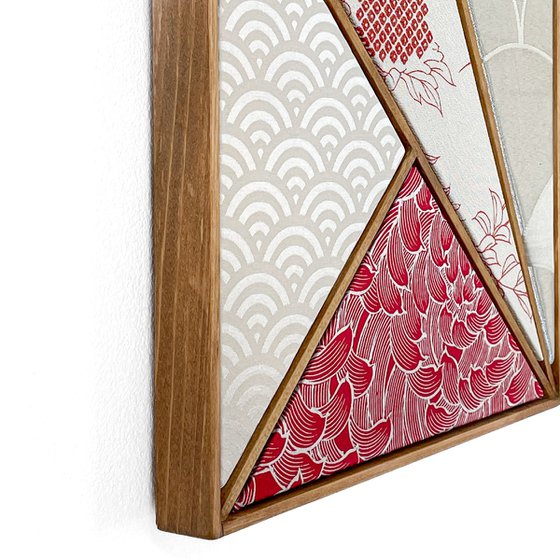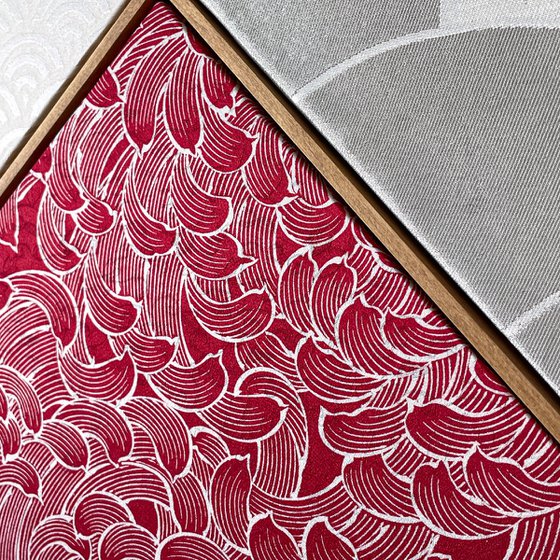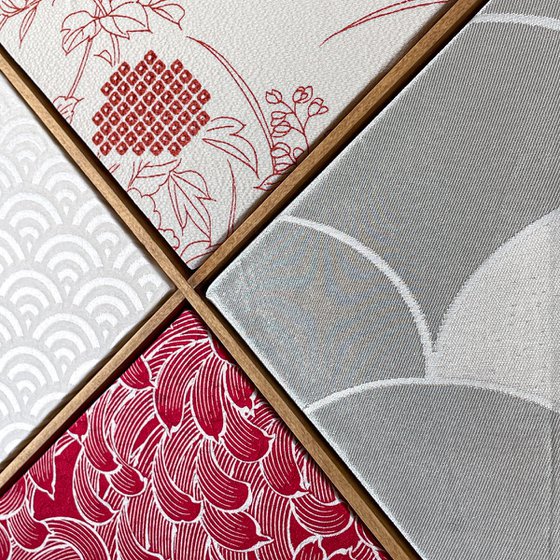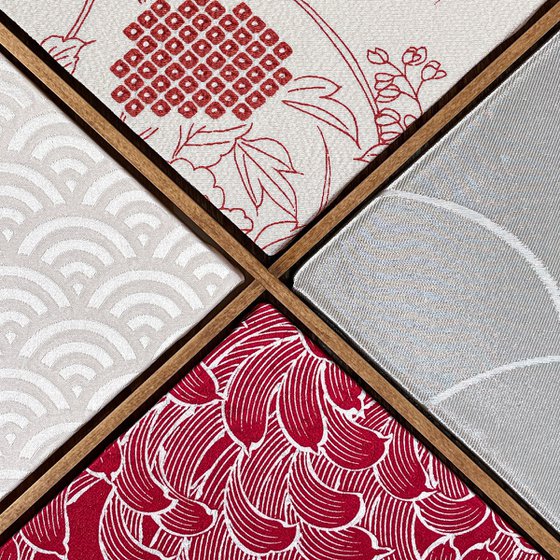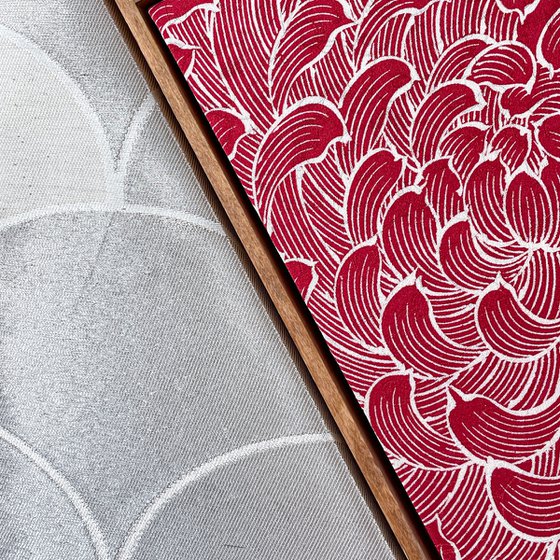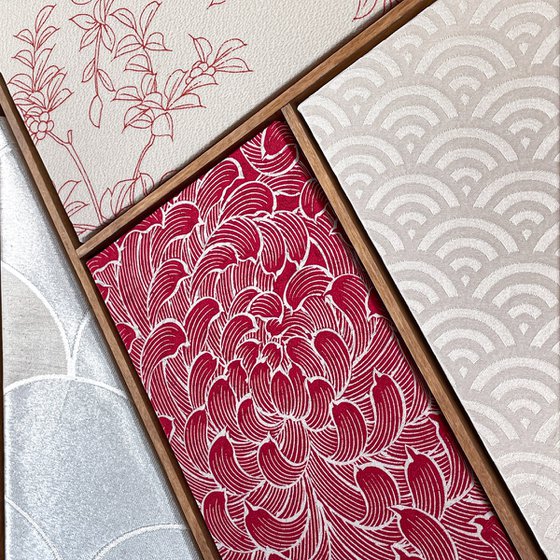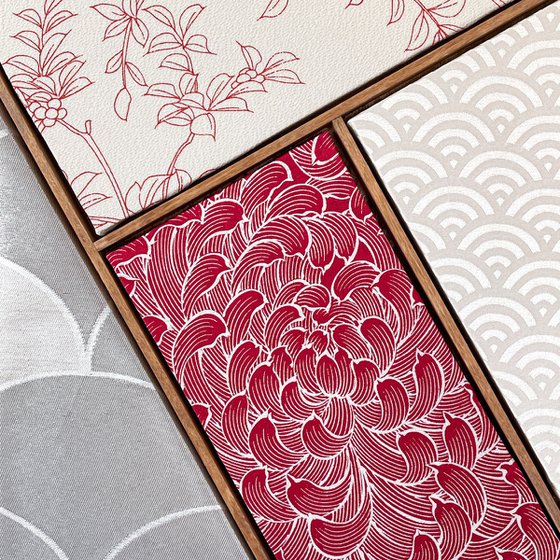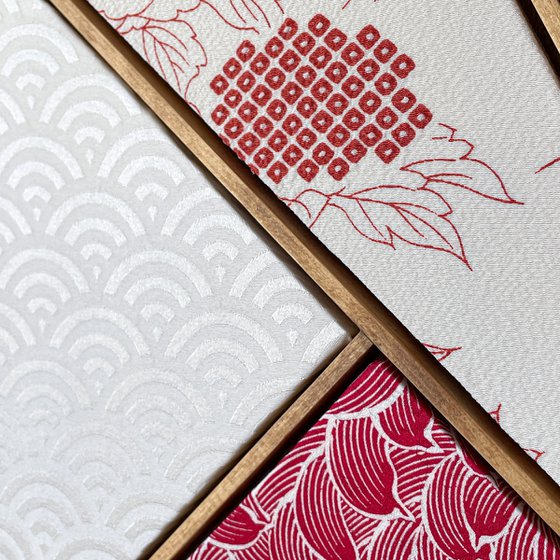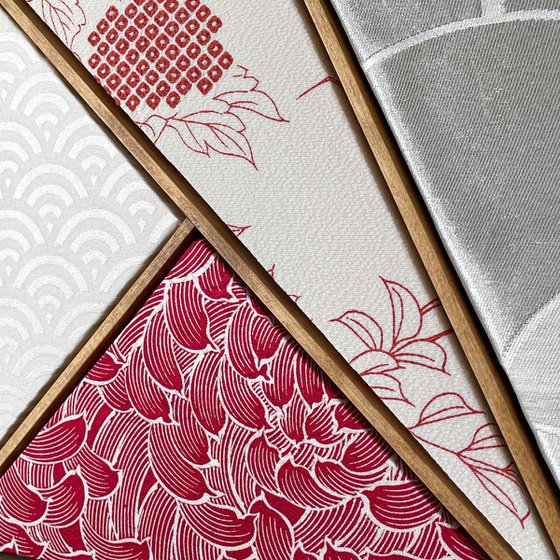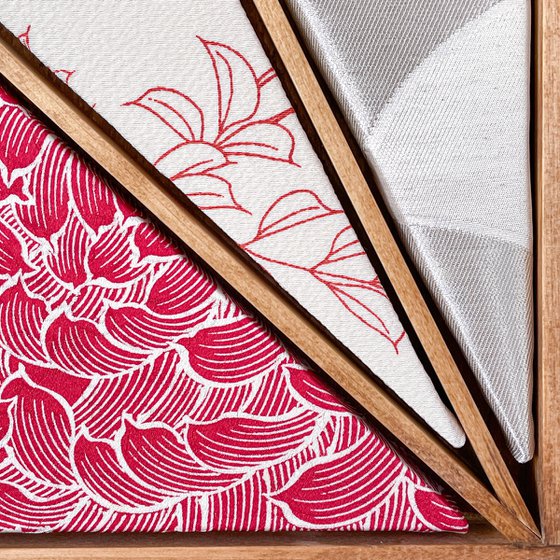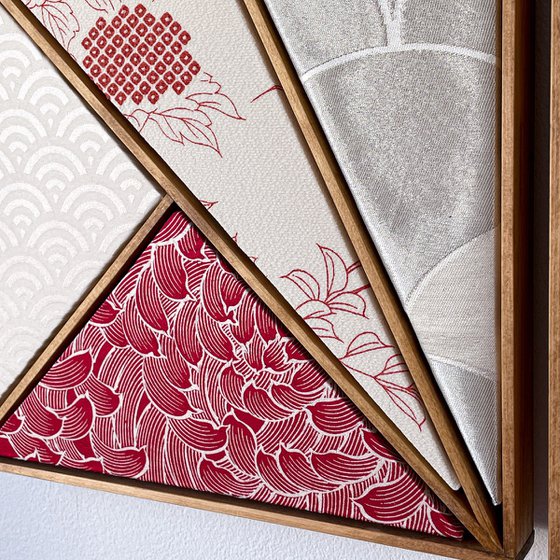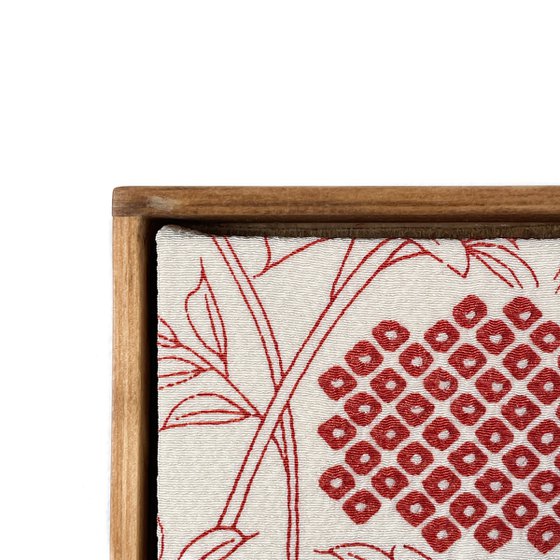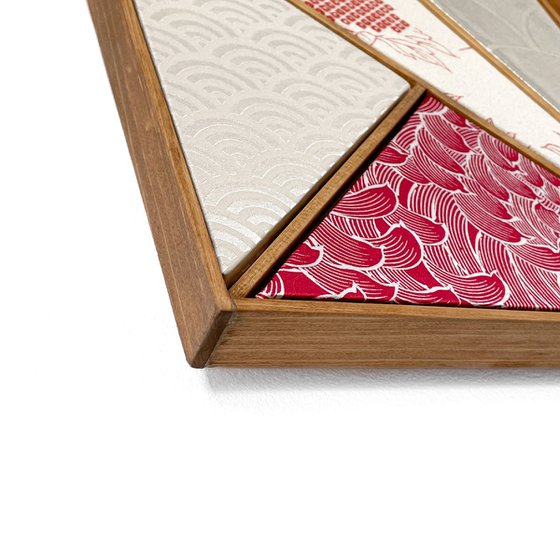Main Navigation
Original artwork description:
[Story behind the work]
This work is inspired by traditional Japanese natural symbolism, and is framed in paulownia wood originally used for a kimono chest-of-drawers.
It is elegantly framed with paulownia wood originally used for kimono chest-of-drawers, and is filled with storytelling and sense of luxury.
I used pieces of kimono that could no longer be used as clothing and kiritansu chest-of-drawers that would normally be discarded to create the ultimate upcycled piece.
[Explanation and meaning of pattern and colors]
Chrysanthemums, known as "kiku" in Japanese, hold significant cultural and symbolic meanings in Japan, particularly in the context of kimono patterns:
Longevity and Immortality: Chrysanthemums are often associated with longevity and immortality in Japanese culture. Their ability to bloom late into the autumn season, even after other flowers have withered, symbolizes endurance and resilience. As a result, chrysanthemum motifs on kimono patterns may convey wishes for a long and prosperous life.
Noble Virtues: Chrysanthemums have been cultivated in Japan for centuries and were favored by nobility and aristocrats. As such, they are often associated with noble virtues such as dignity, grace, and elegance. In kimono patterns, chrysanthemums may be used to evoke a sense of refinement and sophistication.
Imperial Symbol: The chrysanthemum is the national flower of Japan and is closely associated with the Imperial Family. It appears on the Imperial Seal of Japan and is used as a symbol of the emperor and imperial household. Chrysanthemum motifs on kimono patterns may therefore evoke a sense of patriotism and reverence for the imperial institution.
Seasonal Beauty: In addition to their symbolic meanings, chrysanthemums are admired for their beauty and variety. Different varieties of chrysanthemums bloom in a wide range of colors, shapes, and sizes, making them popular subjects for artistic expression. Chrysanthemum motifs on kimono patterns may capture the seasonal beauty of these flowers, particularly during the autumn months when they are in full bloom.
Overall, chrysanthemum motifs on kimono patterns carry rich cultural and symbolic significance, representing themes of longevity, nobility, patriotism, and seasonal beauty. They add depth and meaning to the design of the kimono, reflecting the wearer's appreciation for tradition, nature, and the artistry of Japanese craftsmanship.
[About the frame]
Kiritansu - chest-of-drawers for kimono, is traditionally made from paulownia wood, a uniquely Japanese material closely tied to the world of kimonos.
Paulownia wood is known as the lightest wood in Japan, prased for its natural luster, resistance to moisture, and resilience against cracking. Since ancient times, it has been used in crafting furniture, chests, and musical instruments.
During the Edo period, it became customary to store cherished kimonos in paulownia chests, which offered fire resistance and protection from moisture and insects.
Traditionally, when a daughter was born, a paulownia tree would be planted. Upon her marriage, the tree would be cut down, and the wood would be used to craft a chest for her as a wedding gift.
Following the Ansei Earthquake during the late Edo period in 1855, paulownia chests gained popularity due to their ability to withstand fires and even float in water, thereby safeguarding their contents during floods.
I use antique kiritansu that can’t be used as furniture anymore to create basis and frames for my works. It adds them even more authentic atmosphere of traditional wabisabi spirit. Can you feel it?
Materials used:
silk (outside-layer) , wooden frame (paulownia)
Geometry ~Chrysanthemums~ (2024) Collage
by Lena Okamoto
£1,555.31
- Collage on Other
- One of a kind artwork
- Size: 90 x 40 x 4cm (framed)
- Framed and ready to hang
- Signed certificate of authenticity
- Style: Collage
- Subject: Abstract and non-figurative
Loading
Original artwork description
[Story behind the work]
This work is inspired by traditional Japanese natural symbolism, and is framed in paulownia wood originally used for a kimono chest-of-drawers.
It is elegantly framed with paulownia wood originally used for kimono chest-of-drawers, and is filled with storytelling and sense of luxury.
I used pieces of kimono that could no longer be used as clothing and kiritansu chest-of-drawers that would normally be discarded to create the ultimate upcycled piece.
[Explanation and meaning of pattern and colors]
Chrysanthemums, known as "kiku" in Japanese, hold significant cultural and symbolic meanings in Japan, particularly in the context of kimono patterns:
Longevity and Immortality: Chrysanthemums are often associated with longevity and immortality in Japanese culture. Their ability to bloom late into the autumn season, even after other flowers have withered, symbolizes endurance and resilience. As a result, chrysanthemum motifs on kimono patterns may convey wishes for a long and prosperous life.
Noble Virtues: Chrysanthemums have been cultivated in Japan for centuries and were favored by nobility and aristocrats. As such, they are often associated with noble virtues such as dignity, grace, and elegance. In kimono patterns, chrysanthemums may be used to evoke a sense of refinement and sophistication.
Imperial Symbol: The chrysanthemum is the national flower of Japan and is closely associated with the Imperial Family. It appears on the Imperial Seal of Japan and is used as a symbol of the emperor and imperial household. Chrysanthemum motifs on kimono patterns may therefore evoke a sense of patriotism and reverence for the imperial institution.
Seasonal Beauty: In addition to their symbolic meanings, chrysanthemums are admired for their beauty and variety. Different varieties of chrysanthemums bloom in a wide range of colors, shapes, and sizes, making them popular subjects for artistic expression. Chrysanthemum motifs on kimono patterns may capture the seasonal beauty of these flowers, particularly during the autumn months when they are in full bloom.
Overall, chrysanthemum motifs on kimono patterns carry rich cultural and symbolic significance, representing themes of longevity, nobility, patriotism, and seasonal beauty. They add depth and meaning to the design of the kimono, reflecting the wearer's appreciation for tradition, nature, and the artistry of Japanese craftsmanship.
[About the frame]
Kiritansu - chest-of-drawers for kimono, is traditionally made from paulownia wood, a uniquely Japanese material closely tied to the world of kimonos.
Paulownia wood is known as the lightest wood in Japan, prased for its natural luster, resistance to moisture, and resilience against cracking. Since ancient times, it has been used in crafting furniture, chests, and musical instruments.
During the Edo period, it became customary to store cherished kimonos in paulownia chests, which offered fire resistance and protection from moisture and insects.
Traditionally, when a daughter was born, a paulownia tree would be planted. Upon her marriage, the tree would be cut down, and the wood would be used to craft a chest for her as a wedding gift.
Following the Ansei Earthquake during the late Edo period in 1855, paulownia chests gained popularity due to their ability to withstand fires and even float in water, thereby safeguarding their contents during floods.
I use antique kiritansu that can’t be used as furniture anymore to create basis and frames for my works. It adds them even more authentic atmosphere of traditional wabisabi spirit. Can you feel it?
Materials used:
silk (outside-layer) , wooden frame (paulownia)
14 day money back guaranteeLearn more
